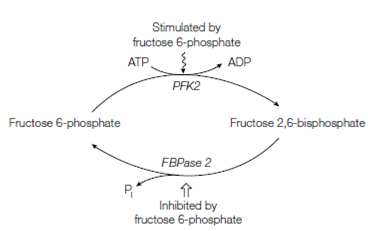Regulation of glycolysis
Phosphofructokinase
The most important control stage of glycolysis is the irreversible reaction catalyzed through PFK (phosphofructokinase). The enzyme is regulated in various ways:
- ATP/AMP. PFK is allosterically inhibited through ATP but this inhibition is reversed through AMP. This permits glycolysis to be responsive to the energy required of the cell, speeding up when ATP is in short supply (and AMP is plentiful) so that more ATP can be made and slowing down when sufficient ATP is already available.
- Citrate. PFK is also inhibited through citrate, the first product of the citric acid cycle proper. A elevated level of citrate signals which there is a plentiful supply of citric acid cycle intermediates already and therefore no additional breakdown of glucose through glycolysis is required.
- Fructose 2, 6-bisphosphate. Fructose 2, 6-bisphosphate (F-2, 6-BP) is synthesized from fructose 6-phosphate through an enzyme known as PFK2 (phosphofructokinase 2), a variant enzyme from PFK and F-2 the 6-BP is hydrolyzed back to fructose 6-phosphate through fructose FBPase2 (bisphosphatase 2). Amazingly, both PFK2 and FBPase2 are activities catalyzed through the similar polypeptide; therefore this is a bi-functional enzyme. The Fructose 6-phosphate stimulates the synthesis of 6-BP and F-2 and inhibits its hydrolysis. F-2, 6-BP in turn powerfully activates PFK and therefore stimulates glycolysis. The whole effect is that when fructose 6-phosphate stages are high PFK and hence glycolysis is stimulated. PFK2, FBPase2 are also controlled through covalent modification. When blood glucose levels fall and the hormone glucagon is released into the bloodstream and triggers a cAMP cascade that leads to phosphorylation of the PFK2 or FBPase2 polypeptide at a single serine residue. This activates inhibits PFK2 and FBPase2, lowering the level of F-2, 6-BP and therefore decreasing the rate of glycolysis.

Figure: Synthesis and degradation of fructose 2, 6-bisphosphate
The reverse is factual as glucose levels increase; the phosphate group is erased from the PFK2 or FBPase2 polypeptide through a phosphatase, therefore inhibiting FBPase2 and activating PFK2, increasing the level of F-2 the 6-BP and hence increasing the rate of glycolysis.
F-2,6-BP is also important in avoiding gluconeogenesis (glucose degradation) and glycolysis (glucose synthesis) operating concurrently. This is known as reciprocal regulation.
- H+ ions. PFK is inhibited through H+ ions and therefore the rate of glycolysis decreases when the pH falls significantly. This avoids the excessive formation of lactate example for. Lactic acid under anaerobic conditions and hence prevents the medical condition known as acidosis a deleterious drop in blood pH.